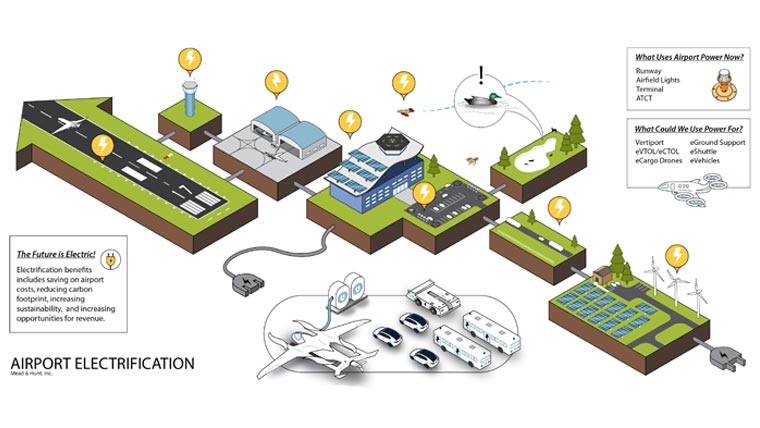Advanced Air Mobility (AAM) and the electrification of aircraft have the world spinning on its head. Many unanswered questions linger regarding how to accommodate electric aircraft at airports and about the differences between electric aircraft and conventional aircraft.
There are four key steps when it comes time to plan and build aircraft charging infrastructure:
- Preparing a site plan,
- Addressing environmental requirements,
- Updating the airport layout plan (ALP), and then
- Constructing and operating according to regulations and grant assurances.
Step 1 – Site Planning
Key factors in site planning include:
- Proximity to electrical utility lines,
- Connectivity between the landing area and charging stations,
- Availability of facilities and services for operators and cargo,
- Sensitivity of impacted environmental resources, and
- Compatibility with airspace surfaces for the charger and aircraft.
Some electric aircraft have wingspans of 50 feet or more. Setbacks and object free areas will need to be checked, and aircraft will need room to park when they are done charging. Begin coordination with your Airports District Office to discuss the proposal, which will help avoid delays down the road. Engaging off-airport stakeholders at this time could be a great outreach move to show how your airport is preparing for sustainable aviation.
Strategically placed chargers can boost airport revenue as operators spend money while the aircraft is charging. Siting chargers near a fixed based operator (FBO) or general aviation (GA) terminal are ways to provide many of the services aircraft operators may need. Installing automobile chargers in adjacent parking lots can help bring in additional airport revenue and leverage any investment in utility extension.
Step 2 – Environmental Requirements
Construction on a federally obligated airport requires some level of environmental review. The Federal Aviation Administration (FAA) will determine its level of environmental oversight through the Section 163 process as described in the FAA Reauthorization Act of 2018. Chargers are generally unintrusive and environmental review is minimal; however, consideration should be given to extensions of utility lines to the charging site. There may be environmentally sensitive areas between where the utilities exist and where they need to be, which could lead to a more complicated project if the sensitive areas cannot be avoided. The Section 163 process requires understanding of how the property where the infrastructure will be built was acquired, so make sure that this information is handy. It is generally located on your Exhibit A property map, or with your local property assessor.
Step 3 – Airport Layout Plan (ALP) Update
The ALP will need to be updated to depict the location of the charging infrastructure and any other modifications required to support access between the landing areas and charging station. This may be a simple pen and ink change if the ALP already depicted the area as an aeronautical use. More substantial changes may require an ALP update, which will be more expensive and time consuming. Coordinate with your Airports District Office early in the process to understand their expectations of the level of effort it will take to update the ALP.
Step 4 – Construction and Operation
Building chargers follows the same principles as any other type of airport construction. FAA Form 7460-1 needs to be submitted for airspace review, a construction safety and phasing plan is needed, and notice should go out to any tenants and users that may be affected by construction activities. Once the charger is up and running, remember that FAA grant assurances apply, and revenue generated at the airport has to be reinvested in the airport.
Going forward, open communication is important during the four steps to implementing electric aircraft charging infrastructure. The future of aviation is rapidly changing, understanding the processes and procedures will lead to efficient electric aircraft operations alongside with its implementation process.



